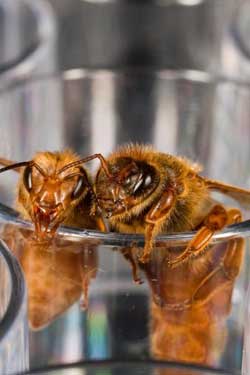Protein love triangle key to crowning bees queens?

A worker bee (left) and queen bee (right) show the vast differences in development that can occur based upon the food a bee receives during its larval stages. These bees were raised in the laboratory of Gro Amdam at Arizona State Univeristy. Housed in plastic dishes, rather than a bee colony, allowed complete control of their diet, and offered researchers the ability to manipulate their gene expression levels and better identify developmental routes. Credit: Christofer Bang<br>
While it has been well established that royal jelly is the diet that makes bees queens, the molecular path from food to queen is still in dispute. However, scientists at Arizona State University, led by Adam Dolezal and Gro Amdam, have helped reconcile some of the conflicts about bee development and the role of insulin pathways and partner proteins. Their article “IIS and TOR nutrient-signaling pathways act via juvenile hormone to influence honey bee cast fate” has been published in the December issue of the Journal of Experimental Biology.
Central to the dispute within the scientific community about “who would be queen” has been a ground-breaking study published in the journal Nature by Japanese scientist Masaki Kamakura in 2011. He found that a single protein in royal jelly, called royalactin, activated queen development in larval bees through interaction with an epidermal growth factor receptor (EGFR). Kamakura's work suggested that insulin signals do not play a role in queen development, despite previous studies suggesting otherwise, including work pioneered with the insulin receptor protein by Amdam's group.
Undeterred by Kamakura's findings, Dolezal, a doctoral student, and Amdam, a Pew Biomedical Scholar and professor in ASU's School of Life Sciences, looked for ways to resolve the disparity between the research studies. Amdam's team's first step involved taking control of the insulin receptor's partner protein, IRS, which the insulin receptor relies upon for signaling. The scientists found that by blocking IRS, they caused a central developmental hormone to crash, which forced larval bees into the worker mold despite their diet of royal jelly. Amdam's team then “rescued” the now worker-destined bees. They found that by giving the bees hormone treatments, the bees could then develop along the queen trajectory.
However, while Dolezal and Amdam's studies showed that they could block queen development, and then rescue it, and clarified the role of IRS in the queen-making process, their work could not resolve the remaining conflict with Kamakura's results.
Taking a new tack, the Amdam group, which also included Navdeep Mutti, Florian Wolschin, and Jasdeep Mutti, and Washington State University scientist Kulvinder Gill, turned to mathematical modeling, combining their results with approaches that analyze potential partner interactions. These models, developed to understand and clarify complex relationships in physics and biology, allowed the ASU researchers to build a model of consensus – explaining how the IRS partner protein could partner to both epidermal growth factor receptor and the insulin receptor. And while the insulin receptor itself may play no role – as Kamakura's findings suggest – Dolezal and Amdam's findings show that the IRS partner protein may in fact be key to a molecular love triangle, interacting with both receptors, and with the bond to epidermal growth factor receptor being the crowning feature in queen development.
Media Contact
More Information:
http://www.asu.eduAll latest news from the category: Life Sciences and Chemistry
Articles and reports from the Life Sciences and chemistry area deal with applied and basic research into modern biology, chemistry and human medicine.
Valuable information can be found on a range of life sciences fields including bacteriology, biochemistry, bionics, bioinformatics, biophysics, biotechnology, genetics, geobotany, human biology, marine biology, microbiology, molecular biology, cellular biology, zoology, bioinorganic chemistry, microchemistry and environmental chemistry.
Newest articles

Skyrmions move at record speeds
… a step towards the computing of the future. An international research team led by scientists from the CNRS1 has discovered that the magnetic nanobubbles2 known as skyrmions can be…

A flexible and efficient DC power converter for sustainable-energy microgrids
A new DC-DC power converter is superior to previous designs and paves the way for more efficient, reliable and sustainable energy storage and conversion solutions. The Kobe University development can…

Technical Trials for Easing the (Cosmological) Tension
A new study sorts through models attempting to solve one of the major challenges of contemporary cosmic science, the measurement of its expansion. Thanks to the dizzying growth of cosmic…





















